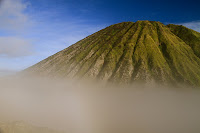 Although this is categorically speaking, neither flora nor fauna, volcanoes are one of mother-nature's most amazing creations. It would therefore seem appropriate that I blog about my recent experience to Mount Bromo, one of Indonesia's most spectacular volcanoes.
Although this is categorically speaking, neither flora nor fauna, volcanoes are one of mother-nature's most amazing creations. It would therefore seem appropriate that I blog about my recent experience to Mount Bromo, one of Indonesia's most spectacular volcanoes. As the tickets for Siem Reap and Solo City were sold out, I spent the last weekend in East Java, mainly to see Mount Bromo, one of Indonesia's many active volcanoes. The Tengger volcanic complex which includes the caldera of the Mount Bromo, Mount Batok and Mount Semeru (collectively incorporated as the Bromo-Tennger-Semeru National Park), is probably one of the most photographed volcanoes in Indonesia.
The 16-km-wide Tengger caldera is located at the northern end of a volcanic massif extending from Semeru volcano. The massive Tengger volcanic complex dates back to about 820,000 years ago and consists of five overlapping stratovolcanoes, each truncated by a caldera. Lava domes, pyroclastic cones, and a maar occupy the flanks of the massif. The youngest of these is Mount Bromo.
Mount Bromo is still very much an active volcano, having erupted in June 2004, killing two people, one of whom was a young Singaporean girl. Standing at 2,329 metres (7,641 ft) above sea-level, it is by far the most popular tourist attraction in East Java and perhaps, one of the few reasons why people would fly into Surabaya, gateway to Mount Bromo. Mount Bromo can be done as a day trip (though strictly speaking, departure is usually done at night from Surabaya's city centre) but if you treasure your life and don't want to put your life it in the hands of a sleepy driver who has to negotiate not just the roads, but also the dark winding corners up the mountain, then it's probably better to check into one of many lodges dotted throughout the caldera and catch the sunrise from there.
Mount Bromo sits in the middle of a vast plain called the Sand Sea (Indonesian: Lautan Pasir), a protected nature reserve since 1919. The typical way to visit Mount Bromo is from the nearby mountain village of Cemoro Lawang which is popular with backpackers due to cheap lodging in the area. Families and the more well-heeled usually head for proper hotels such as Bromo Cottages or the Java Banana which are located in nearby villages. Cemoro Lawang is also the only village which has views of Mt. Bromo.





















Normally, visitors would arrange (through their hotel) for a 4WD to take them to Mount Penanjakan which is the highest look-out point on the northern rim of the caldera. Visitors should leave their hotels at 3:30am and arrive at the look-out by 4:30am in order to secure a spot which promises a vantage view. The journey up to the look-out, which takes about 45 minutes, is both exciting and treacherous because it is dark, there aren't any proper roads and your life really depends on the skill of the driver. It is possible to walk up though one would be doing so in the dark and it'll probably take you 2 hours, which means you'll need to get up even earlier. It's amazing to see throngs of visitors and local tenggerese just waiting quietly in the dark, with cameras aiming at generally the same direction, waiting for first light to break through the clouds in the distance. Temperatures can vary from 0 to 5 or 10 degrees, depending on the wind-chill factor. One of the more interesting things to do whilst waiting is watch the night sky and the countless number of stars dotted above, a sight few people get to see these days. The sun rises at about 5:10am and by 6am, it is usually time to head back to your 4DW for the journey down to the foot of Mt. Bromo.
The steep road down to the floor of the caldera comes out opposite to Mount Batok, with Mount Bromo in the background. The floor of the caldera is fine volcanic sand, which is often called the Sand Sea or Lautan Pasir. Crossing the Sand Sea is usually done by jeep. On rounding the base of Mount Betok, you're greeted by two rather incongruous sights. One is a Hindu Temple, and the other are the 'cowboys'. The temple is a remnant of the Hindu Tengger people who stayed behind when the Majapahit empire fell. The cowboys are there to sell you their services, or rather, the services of their horses.
Just beyond the Hindu temple are the lower slopes of Mount Bromo. The jeeps only go as far as this, and the choice is to either walk across the slick volcanic sands to the base of Bromo's cone, or ride one of the horses on offer. Most people goes on the ponies, probably because it's included in the price of the tour. The horses will take you only to the base of the steep sides of the cone. From there you have to climb a rather steep stairway. Once at the top, the view is breathtaking and a sight to behold.








































